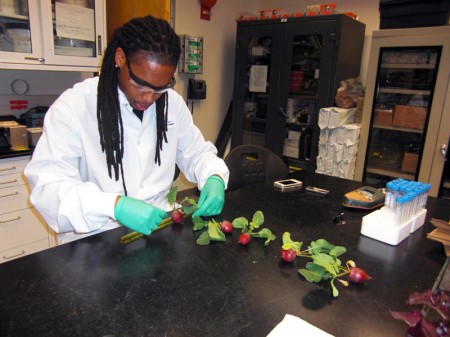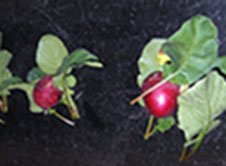Sep
13
Will LEDs Be Your Next Grow Light?
September 13, 2012 | 1 Comment
An idea that originated with NASA as far back as the late 1980s is back as a group of plant biologists is seeking the answer as it works on one of NASA’s Advanced Exploration Systems (AES) Habitation Projects at Kennedy Space Center’s Space Life Sciences Laboratory.
Right now the horticulturalists, green house operators, aquarium lovers and even the basement grower of recreational pharmacologicals are all eager to see a big drop in the power bills to get the grow light bill down.
But NASA is interested in what kind of food astronauts will eat and what is the best way to grow it during deep space exploration missions. It’s looking like one of those technologies that will impact the economy in a good way.
Dr. Ray Wheeler, leader for advanced life support activities in the Engineering Directorate, explains the NASA look at LEDs in the late 80s led to NASA-funded tests done at the University of Wisconsin and at Kennedy using wheat and just red LEDs with the wheat plants growing very leggy and almost bleached out. Wheeler said, “Blue LEDs weren’t very good back then, so using blue fluorescent lights helped correct those problems,” Wheeler said. “Today’s LEDs have vastly improved in their efficiency.”
Gioia Massa, a NASA Postdoctoral Fellow in the Surface Systems group of Kennedy’s Engineering Directorate, works on the AES Habitation-related Project. For the experiment they looked at the responses of a red leaf lettuce called “Outredgeous” and Cherry Bomb radish plants to different light sources – broad spectrum fluorescent lighting and solid state red and blue LED lighting.
Maasa reports, “LED lights are efficient and versatile. Because of their durability and long life, they are ideal for space missions where a resupply of things from Earth is limited.”
Dr. Matthew Mickens, a graduate of North Carolina Agricultural and Technical State University and recipient of the NASA-sponsored Harriett G. Jenkins Predoctoral Fellowship, followed the plants’ growth during his tenure at the center.
During a recent harvest of the plants, Mickens measured the plants’ shoot length, the shoot diameter, total fresh mass or the weight of the plants at time of harvest, total dry mass of the edible plant matter accumulated during the growth cycle, and the leaf area index. He used a chlorophyll meter to measure chlorophyll content.
Then Mickens flash-froze some of the plants in liquid nitrogen and ground them to a powder in order to perform a new test, an adenosine triphosphate analysis, which measures stored energy in the plant tissue. “One of the objectives of the study was to understand the effects of green light on plant growth,” Mickens said.
For the test, he compared the growth responses of the lettuce and radishes grown under a treatment of red and blue LEDs, and a treatment of broad spectrum white fluorescent lamps with green light present. “I discovered that there were considerable physiological differences between the two treatments,” Mickens said.
Mickens results showed darker red color under the red and blue LEDs, which indicates a higher concentration of anthocyanin, a powerful antioxidant that can combat some of the effects of cosmic radiation. Additional replications of the crop cycles are currently ongoing to further confirm these observations.
“Even subtle changes in light quality can potentially increase antioxidant properties of crops such as the lettuce used here,” Mickens said. “The nutritional quality of the vegetables meant to feed our astronaut explorers can be controlled by proper selection of lighting used to grow these crops during long range space missions beyond low Earth orbit.”
There is evidence that supports fresh foods, such as tomatoes, blueberries and red lettuce are a good source of antioxidants, according to Wheeler, who said, “How they are grown and then consumed in space could have a positive impact on people’s moods and could protect against radiation in closed environments.”
Massa concludes the news with, “As we learn more about different light sources we can better configure the lights to more efficiently produce plants that will produce food for the crew, recycle the atmosphere and help to recycle water. Ultimately, we would like to develop closed-loop bioregenerative technologies that are self-sustaining. Our current supplemental food production system is a step towards this future goal.”
For now in the real world there are still quite a few halogen, metal halide, and simple incandescent lights driving plant growth – all at considerable expense for power. A broad spectrum florescent is a major improvement in operating expense at a considerable investment. LEDs would now offer even better operating costs and should soon offer a lower investment.
When one factors in the transport costs for fresh produce in the winter its easy to understand the growth of the hothouse market for produce. Low cost power would extend the ‘day’ allowing more production closer to where the people are.
Whether is flowers, vegetables or fruit, a better quality fresh food supply over a longer season for a lower price is food as fuel we all use and can always enjoy with lower pricing. This market could drive LED adoption faster and is welcome news indeed.
Thanks to NASA’s look way down the road we should see real world result fairly soon.
Comments
1 Comment so far




There are so many different kinds of grow lights. It is really amazing to see how they came up with this. I had no idea that NASA was the one to start looking into this. It is really interesting. Thank you so much for this great article.